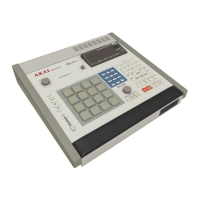Section 8: Syncing to tape and other devices 183
40 milliseconds after 5 minutes. This caused no problem when using
only the MPC60 for all sequenced overdubs to a recording.
However, when using the MPC60 for some overdubs to SMPTE,
and a different SMPTE to MIDI CLOCK converter for other
overdubs to SMPTE on the same recording
in (all at the same
tempo), an inaccuracy would exist between the 2 units, causing them
to gradually slip out of sync.
This inaccuracy problem has been corrected in version 2.0 software.
However, it is necessary to be able to select the older inaccurate
conversion method when working with older recordings in which
an MPC60 running software before version 2.0 was used to record
parts in sync to SMPTE. If not, the new parts will gradually slip out
of sync with the existing parts. For this reason, when adding parts
to a recording in which existing tracks were already recorded by an
MPC60 running software before version 2.0 in sync to SMPTE, set
the "SMPTE accuracy" field to "BEFORE VERS 2.0".
NOTE 1: Some existing devices which convert SMPTE to MIDI CLOCK
signals have internal accuracy problems, including the Roland SBX-80. For
this reason, when adding MPC60 parts in sync to SMPTE to a recording in
which existing tracks were already recorded using a different SMPTE to
MIDI CLOCK converter (all at the same tempo), it is still possible that the
MPC60 parts will gradually slip out of sync with the existing parts, due to
inaccuracy problems in the other converter. For this reason, it is a good rule
to only use one SMPTE to MIDI CLOCK converter for all tracks of a
recording. For example, if the SBX-80 was used on some tracks, use it for
all tracks; if the MPC60 was used for some tracks, use it for all tracks.
NOTE 2: The setting of this field only affects reading SMPTE- it has no
effect on SMPTE generation. Further, the above stated inaccuracy
problem never had any affect on SMPTE generation. Therefore, any
SMPTE code generated by the MPC60 at any time, regardless of software
version, is perfect.
• The MODE field in the SYNC OUTPUT SETTINGS section (appears
in all sync input modes):
This field is used to select which of two types of sync signals will be output
through the SYNC OUT jack while the MPC60 is playing. SMPTE time
code is not output while the MPC60 is playing, but rather only while
stopped - this is explained further under the <GenSMPTE> soft key,
below. There are two options for this field:
1. FSK24:
This is a standard general purpose tape sync code commonly
used in drum machines and sequencers. It

